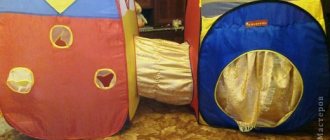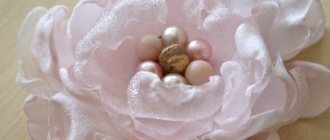The fan came to us from the East. The first mention of it dates back to China in the 8th-2nd centuries BC. It appeared in Europe at the beginning of the 17th century thanks to the Jesuits and traders who collaborated with China. And it gained unprecedented popularity and significance at the courts of European emperors. It got to the point that during the Baroque and Rococo periods, the fan was part of ceremonial actions and communication between aristocrats. For example, ladies could open their fans only in the presence of the queen. As for communication between people, if a woman touched her lips and heart with an open fan, then she told her chosen one that he was her ideal. If you wanted to show the suitor that he was not suitable at all, then the fan was applied with your right hand to your left cheek. We invite you to plunge into this world and learn how to make a fan with your own hands.
We make the fan ourselves
If you are a creative person and want to show your imagination, make a wall fan with your own hands. To do this, stock up on the necessary materials:
- paper or fabric;
- wooden skewers;
- materials for decoration;
- threads, needles;
- glue.
If you have decided on the size and color of the fan, it's time to get to work. Cut out a blank from the base material, fold it like an accordion, smoothing the folds, and secure the edges with wooden skewers. Threads and needles are needed to connect the ends of the fan. With the help of decor, you can decorate the fan as you want; for this you need a glue gun and a variety of ribbons, rhinestones, beads, and braid. The handle can be made from cardboard, plywood and glued using super glue on both sides. Once your piece is ready, secure the fan with the fan facing up.
Japanese fan
You will need:
- Paper with a patterned design, preferably Japanese themed - a sheet approximately 50-60 centimeters long. In principle, any paper will do, but a product made from special paper purchased at a craft store will look more professional.
- Glue “Moment Crystal” or glue gun.
- Scissors, tape.
- Two flat sticks (you can use Eskimo ice cream).
Step by step process
Carefully, slowly, fold the strip of patterned paper into a tight, uniform accordion pattern in increments of 1-1.5 cm. Wrap the lower part of the fan with tape. To be safe, it is better to make several turns. Glue flat sticks to the edges of the fan.
Important! The sticks must rest against the tape, and under no circumstances go over it, otherwise the fan will not be able to open.
- Paper toys - diagrams, ideas and options for making various toys with your own hands (110 photos)
- Dymkovo toy - modern collections, their creation and features of making Dymkovo toys (115 photos and videos)
Knitting openwork patterns - diagrams and step-by-step master class on how to knit an openwork pattern quickly and easily (95 photos + video)
Unfold the finished product - your DIY Japanese fan is ready!
After practicing on these simple models, you can move on to more complex options - made of fabric, feathers, using the fan principle, or wall masterpieces!
Paper fan
A fan is the most common paper craft. Making a paper fan is quite simple, but there are some subtleties.
Fold an ordinary sheet of double-sided colored A4 paper in half along the transverse line. Open the sheet, bend each edge to the center line. Open it again and there are three folds.
Fold the edge closest to you to the first marked line - another fold is formed. Unfold and fold the same edge to the far (upper) marked line. This is the next fold. Do all these steps with the opposite edge of the sheet.
Open the workpiece and turn it over with the folds facing up. Fold the edge of the sheet closest to you to the first convex fold.
Grab the first convex fold and fold it to the second. Continue folding the paper like an accordion, grabbing each convex fold and folding it to the next one. Fold the last convex fold to the edge of the sheet.
Now fold the resulting accordion in half, first bending one free edge. Bend the accordion so that the bent edge is inside the bent accordion (does not bend around it from above). Fold the corners of the bent edge - bend the upper corners together downwards, and the lower ones upwards.
Fold the bent edge with the folded corners into the middle of the accordion. Unfold the fan and hide the part with the bent corners inside. Use your fingers to press the folds well. To uncover. Your DIY paper fan is ready!
Original fan
You will need: 3 sheets of different sizes and colors, scissors, hole punch, glue, elastic band or rope or tape.
Master Class
- Fold the first (smallest) sheet of paper in half twice and punch holes with a hole punch.
- Cut fringe along the edges of the second sheet.
- Gather the sheets together and fold the accordion.
- Tie in the center with a ribbon.
- Glue the 2 halves of the fan together.
- Use your fingers to shape the fringe.
The original paper fan is ready!
Kinds
It is difficult to say when fans first appeared. They are known in different countries and cultures. A fan can be any object that is designed to fan oneself or others with wind currents.
In hot countries, slaves stood above their rulers and constantly waved huge structures on a long handle over them. In medieval Europe, every young lady had a whole collection of hand fans of different colors and configurations. Some of them were even decorated with precious stones.
But most of the varieties appeared in Japan, where there was no shortage of paper - the basis for the fan. Here we know both the beam designs that are familiar to us, and products made entirely of paper, on a handle, which when unfolded resemble a leaf of a tree, and when folded they are completely hidden in the handle.
There is also a non-folding fan made of paper and other dense materials. It is also attached to a handle, to which a strap is attached to make it more convenient to carry. Such a fan is decorated with paintings of scenes from everyday life, religion, or landscapes of Japanese nature, which have features characteristic of this culture.
DIY fan of twists: master class
Even preschool children can make a fan of disposable forks. Although this will require a little help from adults. Materials you need to create this craft:
We begin creating crafts and making a frame. We will glue plastic forks onto it. Cut the disk in half and decorate it with colored paper. Next you need to glue the forks halfway on the disk. It is also possible to create a fan of presentations. The step-by-step instructions remain the same. When all the forks are glued, then you should move on to the decor. For decoration we use satin ribbons: they need to be beautifully wrapped around the forks. You can take ribbons of two colors. They must be used to cover the beginning of the tines of the forks. A fan of plastic forks can be considered complete if lace is attached between the teeth. It must first be stitched, gathering folds on one side.
From plastic forks
Materials and tools:
- disposable forks - odd number (from 19 pieces);
- wide lace - 1 meter;
- decorative elements (rhinestones, feathers, satin ribbons);
- white cardboard;
- corrugated cardboard;
- CD;
- cup;
- Super glue;
- pencil;
- scissors.
Master Class:
- Trace a disk on a sheet of cardboard, cut it out, and divide it exactly in half.
- On a sheet of corrugated paper, outline the neck of the glass, cut out the resulting circle and divide it in half along the diameter.
- Glue a small one to the large semicircle, aligning them along the cut edges.
- Insert plastic forks into the holes of the corrugated paper until they stop, gluing them to the main semicircle, trying to ensure that the teeth of adjacent forks touch (only an odd number is required).
- Glue the second large semicircle on top of the corrugated cardboard on the workpiece.
- Glue a satin ribbon to one edge of the fan and weave it between the forks. Continue weaving until the teeth are reached, then secure the ribbon at the edge and glue.
- Glue a decorative feather to each fork.
- Cover the attachment point with openwork tape.
- Glue velvet and a ribbon flower onto a cardboard handle.
Folding paper fan
You will need: a blue A4 sheet, scissors, pencils and markers, 2 long ice cream sticks, a blue elastic band, regular tape, double-sided tape.
Master Class
- Fold and cut the sheet in half, then draw a design.
- Fold the blanks like an accordion.
- Glue the blanks together.
- Fold the fan and secure the base with tape.
- Attach the sticks with double-sided tape.
- Fold the fan and secure at the top with an elastic band.
The folding paper fan is ready!
What materials and tools are needed for the job?
The choice of materials depends on where and how the finished product will be used. If this is an accessory worn by a lady, then a more durable structure that can be folded is needed.
To make this option you will need wooden sticks or long skewers. For simpler models, cocktail straws can be used. The same set of basic materials is necessary if it is to decorate the interior. But in addition to the frame, it is important to think about the foundation. Usually these are good quality textiles.
When choosing fabric, you should pay attention to the color and print. It is advisable to select red fabrics with gold monograms.
To make the simplest options, paper or cardboard is used. Additionally, in each case you need a glue gun, scissors, a pencil with a ruler, and decorative attributes.
How to make a Japanese fan with your own hands: step-by-step instructions
There are several options regarding how to make a fan. In this case, different materials and techniques are used. Some schemes are quite complex, while others can be handled even by a small child.
From cardboard
Using just 1 sheet of double-sided cardboard and a stapler, you can make the most primitive version of a fan. At the same time, the design is very functional - the body folds and unfolds at the right time. If necessary, you can think about decoration.
The principle of making a cardboard fan in the Japanese style:
- Fold the cardboard sheet into a small accordion.
- Secure the base of one of the ends with a stapler.
- If desired, decorate with elements made of colored paper using the applique technique.
The material is quite easy to process, so a child in the preparatory group of a kindergarten can also make and use a ready-made model.
From fabric
It is not difficult to make a fabric product, but it looks very attractive. This craft can be used to decorate the interior of a room or as an accessory. For work you will need the following tools and materials:
- interlining;
- textile;
- PVA glue;
- glue gun;
- wooden sticks;
- wire;
- stationery needle;
- compass and scissors;
- pencil and ruler.
Master class on making a textile fan:
1. On one side of each stick, using a ruler and pencil, measure the same distance - approximately 3 cm.
2. Using a stationery needle, make a hole at each marked point.
We recommend reading: How to draw a hut on chicken legs
3. Fold the wooden elements, matching all the resulting holes. Thread a piece of wire through the holes and secure with a loop on both sides. The frame for the fabric base is ready.
4. Cut a rectangle from non-woven fabric. You first need to try on the frame on the base, since the figure should be approximately 2 times larger. Using a compass, draw a semicircle (diameter 5-10 cm) from the middle of the larger side. cut the workpiece.
5. Lay out the non-woven rectangle on a flat surface. Open the frame and attach it to the workpiece. Pre-place each stick in its place. Make notes with a simple pencil on the non-woven fabric. Also mark the edges of the fabric on the sticks.
6. Next, grease each stick to the bottom mark with PVA glue. This must be done evenly and carefully. It's better to use a brush. Glue each stick to the non-woven fabric in its designated place. Trim the excess part of the base at a distance of 5 cm from the edge of the sticks.
7. The fabric base is prepared according to the same principle as non-woven fabric. Cut a semicircle at the base of the textile rectangle.
8. Grease the other side of the wooden sticks with glue. The next step will be fixing the sticks on a fabric base.
9. Trim off excess fabric and interlining at the top. Now you can make a cut close to the sticks.
10. Fold the outer strips from the non-woven side and use a glue gun to bend and glue them to the wooden bases.
Attach a tassel to the wire for decoration and functionality. Thanks to this arrangement, the product is easier to hold in your hand.
This version of the fan can be used in different areas. The design is quite strong and will withstand mechanical stress.
From paper
The easiest way to make a fan is in origami style. To create this option you need the following devices:
- 3 sheets of paper of different colors;
- scissors;
- hole puncher;
- glue;
- ribbon.
Algorithm for how to make a paper fan with your own hands:
- Leave the first sheet unchanged. Reduce the second by cutting a strip 3 cm wide, from the third even more - 6 cm.
- The smallest leaf needs to be processed using a hole punch. Cut the edges of the second into fringe with scissors, and leave the largest one unchanged.
- Place the sheets on top of each other. Fold like an accordion.
- Determine the center of the workpiece. Tie the ribbon into a knot.
- Glue the central strips together.
Spread the fan. Correct all tiers in accordance with the compositional solution.
From scrap materials: forks
To make a Japanese-style accessory, you can use a variety of available materials. Thanks to the thoughtful combination of all the components, you can get a beautiful craft.
To make an item from improvised materials you need the following:
- glue gun;
- satin ribbons of the same thickness;
- wide lace ribbon;
- scissors;
- disposable forks;
- old disk.
Making such a fan is quite simple:
1. divide the disk by diameter and cut in half. Place disposable forks along the workpiece. To do this, you should use a glue gun.
2. Turn the workpiece over so that the disc faces the reflective surface. Thread a lace ribbon through the tines of the forks. Glue the edges of the textile element to the forks.
3. At the base, namely near the disk, satin ribbons are fixed in tiers according to the same principle as lace.
Glue the ribbons to the outer “legs of the forks”. The decorative version of the product is completely ready.
Steps to success
These crafts are popular among the younger generation for good reason: the bright design attracts the eyes of passers-by, and a souvenir of this kind will pleasantly surprise a loved one or parent. The process itself is very entertaining and interesting, helps to reveal the child’s creative potential and develops useful skills in needlework.
Independent work for children will require preparatory processes, the list is not too long:
- Flat-looking ice cream sticks;
- Paper sheet;
- Stationery scissors;
- Multi-colored markers, paints or pencils;
- Soft wire and awl;
- PVA.
Let's start practicing
To begin with, slowly make a hole in each wooden component; later, thanks to it, the frame will be held together. For very young children, this task will be overwhelming, so adult help will not hurt.
The awl will easily pierce the stick if you take each part separately, the main thing is that the punctures coincide with the previous ones. Now, using wire, fasten all the components into one whole, there is no need to tighten the metal too much, the structure should move apart easily and naturally.
Having opened the resulting base, you get a semicircle, apply it to the paper and trace it with a pencil, it’s clear how to draw a fan.
Note!
How to make wooden shelves with your own hands - original design options
Kinusaiga technique for beginners: what is it, a description of creating paintings from threads
- How to weave a figurine from rubber bands: how to learn to weave animals, toys and what you can make from rubber bands on a slingshot
The resulting canvas still needs some work; a blank sheet is unlikely to attract attention or delight others.
Decorating the craft
The cut-out blank is decorated, using imagination and new ideas, it is necessary to apply a drawing and carefully fill the composition with different shades. After creative design, the painting is glued with the reverse side to the finished frame made of sticks, after a while the PVA will dry and the miniature accessory can be used for your pleasure.
With such simple manipulations you can create a useful thing that will be useful in any game or on vacation. The materials are not too expensive, and the time and effort required is minimal.
Fan made of fabric or feathers
Fans made from feathers look much more impressive than modest paper fans, and fabric accessories look more elegant. To create such fans with your own hands, master classes will be very useful.
From plastic forks
A variety of materials are used to make fans. For example, an original fan can be assembled from ordinary plastic forks. And to do this, you will need the following tools and materials:
- 19 disposable forks (you can take more, but be sure to have an odd number);
- lace 1 meter wide;
- feathers;
- satin ribbons;
- rhinestones;
- openwork ribbon;
- corrugated cardboard;
- old disk;
- heat gun;
- white cardboard;
- cup;
- a simple pencil;
- scissors.
The materials for the product must be selected so that the colors are harmoniously combined. Stages of work:
- On white cardboard, draw a disc with a pencil, draw a line in the center of the resulting circle and cut out two semicircles.
- We trace the neck of the glass on corrugated cardboard and cut out a circle, after which we cut it in half.
- Glue a small semicircle to a semicircle of white cardboard, carefully aligning them along the cut edges.
- We insert the forks into the corrugated paper and attach them to the large semicircle with glue. The forks should be positioned so that their tops touch each other.
- The second piece of white cardboard needs to be glued on top of a semicircle of corrugated paper.
- We take a satin ribbon and attach it to the top of the outer fork. Next, we intertwine the ribbon between the tines of all forks and glue it on the other edge.
- We glue a feather to each of the forks on top, and cover the attachment point with an openwork ribbon.
- We glue a corresponding piece of velvet onto the cardboard semicircle from below, and a flower made from ribbons on top.
Fabric fan
A fabric fan can be used as a prop for performances or as an unusual accessory. To make a fan with your own hands from fabric, you will need the following materials:
- 23 wooden sticks with holes at the bottom;
- scissors;
- glue gun;
- paper;
- compass;
- scissors;
- blue paper or tape;
- blue and pink floss threads;
- blue fabric;
- needle.
Wooden sticks for the craft can be taken from an old fan, and the fabric is not too thick.
If you don’t have old sticks, you can cut them out of plywood.
The size of the part is 40x1 cm. The parts need to be stacked and a hole for the thread should be made at a distance of 1 cm from the edge. Manufacturing procedure:
- We take wooden sticks, stack them and thread a pink thread through the hole. After this, we wrap the thread around them from below several times in a circle so that they hold better.
- We fan out the sticks so that they are at the same distance from each other and apply them to the paper. We outline them with a pencil.
- In the resulting semicircle, draw a small semicircle with a radius of 10 cm and cut it out.
- Using the template, cut out the piece from the fabric.
- We apply the fabric to the unfolded sticks and glue its edge to the lowest strip in the fan. After this, the fabric part needs to be glued to the rest of the sticks from below, and completely to the last strip.
- The top of the sticks should be sewn to the fabric with blue thread. You can sew blue tape onto the edges of the fabric to hide uneven cuts.
- After the glue has dried, the fan can be folded.
Chinese method
China can be called the birthplace of the fan. It appeared there in ancient times and was made from different materials: lotus, reed, feathers. A little later, thanks to the Japanese, folding fans appeared in China. You can try to make just such a fan yourself. For this you will need:
- textile;
- ruler;
- thin plywood;
- bolt with nut;
- scissors;
- glue;
- sample.
Stages of work:
- From plywood we cut out 13 parts numbered 1 in diagram A and two parts numbered 2. The dimensions of the parts are indicated in the figure.
- We put the parts together, and place the wider ones along the edges.
- At a distance of 2.8 cm from the bottom of the planks, we make a hole in them and insert a bolt.
- Based on the shape and dimensions in diagram B, we cut out the desired part from the fabric.
- We open the planks in a semicircle so that they are at the same distance.
- We completely cover the left bar with fabric. We glue all other parts to the fabric only with the bottom side.
"Fork" fan
A DIY fork fan is a completely unusual solution!
You will need:
- An odd number of disposable plastic forks (23-25 pieces).
- Self-adhesive foam board. Can be replaced with regular one.
- A scrap of satin fabric in your favorite color.
- Decorative lace with scalloped edge 4 cm wide.
- Wide transparent lace to decorate the base.
- A compass (if you don’t have a compass in the house, an ordinary faceted glass and a CD will serve as a replacement), a simple pencil and scissors.
- Transparent strong glue (“Moment Crystal”) or a glue gun.
- Satin roses of different sizes and rhinestones for decoration.
- Two or three satin ribbons of different colors with a width of 1.5 to 3 cm (optional).
Fan base
Using a compass, draw a circle with a radius of 6 cm on the self-adhesive foam board, or outline a CD. Cut out a circle and cut in half.
We recommend reading: How to make and decorate a carnival mask with your own hands: methods and master classes
Remove the backing protecting the adhesive side. Place each half with the adhesive side on a piece of satin, press, level, gluing the fabric well. Trim the fabric along the edge of the cardboard. Lightly melt the edges with a lighter.
Lay wide transparent lace, gluing it, on top of the satin with scallops down, releasing them beyond the straight edge of the semicircle. Fold the vertical edges of the lace inside out and glue.
Draw a circle of a smaller diameter on the cardboard - with a radius of 3.5 cm, or outline the top of the glass. Cut and cut in half too.
Turn the large semicircle with the wrong side facing you and stick a small semicircle on it, aligning the centers of the semicircles. The small semicircle will act as a limiter.
Frame
Glue the forks to the base, tines up, one after the other. The fork rods should rest against the border of the small semicircle. The tines of the forks should touch - the sides of the tines can be immediately glued to each other.
Advice! The fork stems can be completely wrapped in satin ribbon, gluing it along the way and fusing the ends.
Glue the second cardboard semicircle face up, covering the structure.
Decor
Carefully thread a colored ribbon 1.1-3 cm wide between the fork rods. It’s better to start from the bottom, melting the end and securing it with glue. At the end, glue the edge of the tape. As the tape moves, also grab it with drops of glue.
Then place a second row of tape between the rods. Let each row go in the opposite direction. There can be two or more rows - right up to the beginning of the teeth.
Pass the wide lace between the tines of the forks, securing it with glue and directing the scallops upward. Melt the ends of the lace and glue them. To make the frame of the fan more romantic, you can glue another, more airy, transparent lace, laying it in folds.
It is good to glue an artificial rose into the base of each fork, for charm and to cover the folds. Rhinestones can be glued onto ribbons and lace, and the base of the fan can be decorated with roses.
As you can see in the photo, this fan is quite beautiful. Such models can even be used in wedding decorations.
To the work room
In every kitchen, women who love to pamper their family with a delicious dinner or baked sweets spend a lot of free time, why not decorate this room and create even more comfort for spending time.
Having practiced enough and understood how to make a circle out of paper with an accordion, you can place it on a frame of plastic forks, the dining area with such decorative techniques will be transformed in a minute.
Plastic disposable tableware will be an excellent material at hand for making decorations for the workroom. By intertwining the design with bright satin ribbons and adding lace in gold or silver, you can add freshness and more light to even the darkest corners, cluttered with various household appliances.
Varieties of fans
Who said you can't cool down on hot days without air conditioning or a fan?
An ordinary fan can cope with this task perfectly. At the height of summer, it can be purchased at any accessory store or even at a kiosk. Despite the abundance of this summer accessory, it is a mistake to believe that they have the same structure, because their variety is simply amazing. This is an ordinary paper fan, an element of home decor, and a classic Japanese (Chinese) fan, which we are accustomed to seeing on store shelves, as well as a fan used in fiery dances, and even a fan.
Knitted fan
For those craftswomen who have crocheting or knitting skills, we offer diagrams describing how you can create a fan using your skills.
Such fans can suit you not only on a weekday, but also, for example, for a masquerade ball. You just need to choose a different thread color and use decor.
Moreover, according to these patterns, you can knit a fan not only with crochet, but also with knitting needles.
Master class from A to Z
Do you think that making a fan with your own hands is labor-intensive? No matter how it is, thanks to a detailed master class you will be able to make this stylish accessory in a matter of hours. And as a result, you will receive an original product, unlike others.
Stylish paper accessory
A fan made of paper is very easy to make and no less beautiful than its more expensive counterparts. If you don’t know how to make a paper fan with your own hands, then pay attention to this simple master class on how to make it. To make a stylish accessory out of paper, you will need:
- Thick paper (preferably colored).
- Cardboard.
- Ruler.
- Glue.
- Scissors.
- Awl.
- Pencil.
- Scotch.
- Decorative cord - 30 cm.
- Large beads - 2 pcs.
Other options and materials
It is also very popular to create fans from non-standard materials. For example, from disposable forks or spoons, as in the video below.
Juice straws also make excellent specimens.
Glue the tubes onto the cardboard base.
If you use a heat gun while working, be careful not to burn yourself or melt the plastic.
Using a stapler, we secure a strip of organza or mesh at the base. We put a fold on each tube.
We cover the cardboard base itself with a piece of beautiful fabric and ribbons.
We continue decorating to the top of the tubes.
As can be seen from the article, fans can be created using various materials and methods. Whether you know how to knit and/or crochet, whether you like to work with paper, non-standard materials, whether you are preparing for summer or a party, you can always find an option that is right for you.
"Heart" decor
For Valentine's Day, you can make your own paper decor for your home using the main symbol - hearts.
Garland of hearts
For a voluminous garland, you need to cut out a lot of hearts from colored paper (you can take bright scrapbook paper with a floral pattern). Fold them 2-3 together, sew them in the center with a strong thread, leaving 30-40 centimeters between the elements. Carefully bend the “petals”, giving the hearts volume. Having prepared several of these threads, attach them to the ceiling or doorway in the form of a curtain.
You can make the garland even more interesting if you take blanks of different sizes and fold them in this way: smallest - medium - large - medium - smallest. Further steps are the same: sew, bend, hang.
DIY paper decor
Decor idea with paper products
Using the quilling technique you can make a bright and unusual garland. You will need scrapbook paper with a floral pattern, bright buttons and glue. To work with scrap paper, it is better to take “Moment” or “Titan”. They will not turn yellow over time. Glue two strips on each side to a small strip of paper (10*2 cm). Bend them one by one and glue the edges. You will get a heart, which can be additionally decorated with bright buttons. All that remains is to attach the hearts to the thread and hang the garland.
"Flower" heart
You will need regular paper napkins and cardboard.
From thick corrugated cardboard (unnecessary boxes), cut out two heart-shaped blanks. Connect them together using a strip of thick cardboard (its width should correspond to the desired thickness of the decorative element). It turns out to be a voluminous heart.
Fold napkins measuring 20*20 cm (without unfolding) in four to form a square with sides 5*5 cm. Staple the layers in the center and cut out a circle. Layer by layer, peel back the petals of the paper flower. The result is a delicate rose. Having made many of these flowers, attach them to a cardboard “heart” blank. A spectacular result will be obtained if you take napkins of a delicate pink color or two colors - white and pink. The result will not leave your “other half” indifferent - a tender heart will decorate the room.
"Love tree"
It’s very simple to make – place several branches in a beautiful transparent vase. Cut out several hearts from red, pink, white paper (you can make them voluminous, like for a garland), hang them on the branches. You can add thin beads
Fire show. Props part 4.
And so we continue. I wrote about poi, staffs, it’s time for beauty. namely fans. Fans for me are the embodiment of grace and beauty.
Before writing this post, fans differed for me in size (the way of working with them), the number of rays, and appearance. However, just posting 3-5 photos of different fans and saying: “I did it” didn’t seem enough to me, I started looking for information and discovered the following thing:
People describing fans divide them not into “spin” and “choreographic”, but into Russian and American. Here's a quote: Traditionally, there are two main types of designs: American and Russian fans. In addition, there are many non-standard designs (folding fans, giant-sized fans and elaborate designs) used mainly for performance purposes rather than for performing tricks. Today, fans of both designs are used everywhere and are no longer localized to any particular country.
Ok, American fans or spiders
American fans, also called “spiders” or “khaos” (after the name of the store), have relatively small sizes (30 – 40 cm), 4 knitting needles topped with wicks, and a small ring (3 – 5 cm in diameter). They often have additional small rings of unknown purpose.
Russian fans, on the contrary, are large in size (more than 35 cm), from five to seven spokes and a ring with a diameter comparable to the width of the palm. Sometimes, just like the American ones, they have an add-on to the ring called a “stopper”, which, however, has more opponents than supporters.
Accordingly, there are two schools:
The American school involves the rotation of fans on one or more fingers, while rotation as such is used relatively rarely, but on the contrary, there is an artistic movement of fans in such a way that various geometric shapes and effects are obtained. Hence the common name for this technique is “geometry”. The tricks themselves are superficially similar to similar elements performed with double staffs and manipulations with a pair of clubs. Such elements are described by the theory of the relative positions of fans. Typical representatives of the American school of fans are such artists as Grimm Zimmer, Corey White, Memory Lena, Ellie Sorokin and others.
The Russian school, on the contrary, involves rotating the fans around the hand in such a way that the fans are in constant motion. At the same time, the tricks performed are often similar to elements with poi. In addition, juggling with two (less often three) fans is widely used. In Russian technique, grips and methods of changing them play a significant role. Typical representatives of the Russian school of fans are such artists as Anna Pevnitskaya (Anika), Alina Pavlova (Alinka-Murka), Rem, Ksenia Falkova and others.
There are spin fans (fans designed for almost constant rotation), they are not large, and the wick is also not large (3-6 cm). Almost all elements are transferred from food.
There are choreographic ones. These animals don't care what size they are. Yes, at least for example
In general, I don’t care about the size (the main thing is that you can hold it in your hands), the number and size of wicks too (the longer the knitting needle, the longer you can cut the wick and not burn the participants), this is where the differences probably end, but as always there are aesthetic background.
People really like the so-called “lotus” fans, look at them
But not everything is so bad in the minds of fire props crafters; there are also such interesting models:
Source
New Year's compositions
Everyone knows how to make openwork snowflakes from a paper napkin. Window decor can be made even more diverse. Elements of the composition are cut out of white paper using stencils - forest, houses, deer and Santa Claus's sleigh. You can come up with many stories.
These elements are placed on the window (you can glue them using paste made from flour or starch). If you want to create a completely magical atmosphere on New Year’s Eve, you can place small light sources nearby. They will shine through paper and glass, creating an unusual effect.
To make the interior beautiful, make the composition three-dimensional by cutting out another one of the same size and placing the lighting between the layers of paper. Add glitter to the interior arrangement.
You can make voluminous Christmas tree cones from paper, decorating them to your liking, or Christmas wreaths. They will create a festive atmosphere in your home.
A wedding, birthday, New Year, and just a desire to do something unusual with your own hands are a good reason to pick up paper. With its help you can do the following things.
- Unusual curtains for the doorway - from long, triangular-shaped multi-colored ribbons, twisting them into a “tube”, starting from the wide side. The finished elements are strung on threads and attached to the opening. Such curtains can be made from colored pages of glossy magazines.
- Panel - laying out its elements from paper strips.
- Volumetric letters – having made a blank like a volumetric heart, you can cover them with scrap paper and decorate them with additional elements.
Show your imagination and come up with your own “paper” room. With such decorative items that keep the warmth of your hands, your home will become even more comfortable and filled with love.
A little history of fans
A fan is a special fan that is designed to create a flow of air on the face, neck, and shoulders in hot and stuffy weather. The first mention of a fan dates back to antiquity. At different times they were made from bird feathers, paper, fabric, etc.
- In Ancient India, a fan was an attribute of royal power, and in Ancient Japan it was a symbol of military strength.
- In Japan, making fans was a real art. They were made round, foldable, framed, with a mirror, made of leather, paper, lotus and reed. Fans were decorated with drawings and calligraphy. The fan is the main attribute of one of the national Japanese dances.
- During the Baroque era, the fan was only available to the royal nobility and aristocracy. In France there were very strict requirements for the manufacture of fans; drawings on them were allowed only on certain topics. Italian craftsmen showed more imagination when making “hand fans”. They were decorated with drawings from mythology, floral designs, drawings on the theme of court life, etc. During the reign of Louis XIV, the fan became an incredibly important item in palace ceremonies. For example, women could only open their fans in the presence of the queen. And a young girl appearing in society for the first time had to master the art of handling a fan.
- In the Rococo era, fans became a real instrument of flirtation and coquetry. Women of the lower classes gained access to this item, but only aristocrats still possessed real skill in handling a fan. With the help of a fan, women could even “talk.” The fan's tongue helped to express sympathy without words or to make it clear to a man that a woman was not interested in him.
- In the 19th century, fans made from ostrich feathers gained popularity. It was at this time that their numbers were significantly reduced. The production of fans was carried out by craftsmen from France, Italy, and Holland.
- The tradition of using fans to decorate a room came to us from the East. There, fans replace paintings on the walls.











